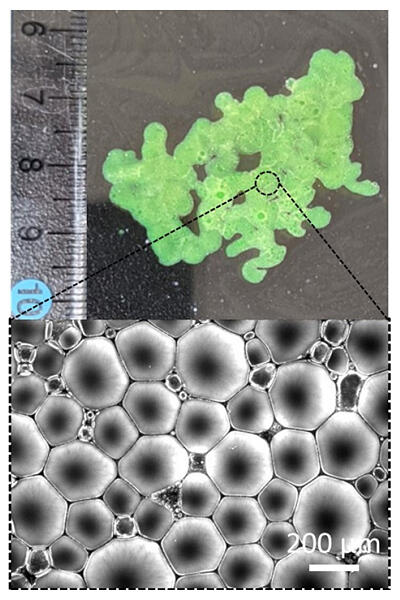It may be possible to easily create molecular robots that can perform specific functions inside and outside the living body to aid in the treatment and diagnosis of diseases. A research group led by Project Researcher Richard J. Archer, Associate Professor Shin‐ichiro Nomura and others of the Molecular Robotics Laboratory, Department of Robotics, Graduate School of Engineering at Tohoku University developed a new method for creating molecular robots from artificial multicellular bodies. Their results were published in the journal Langmuir.

Provided by Richard Archer / Shin‐Ichiro Nomura, Tohoku University
In this study, a simple self‐assembly technique that uses a material in which phospholipids and synthetic surfactants are applied to a hydrophobic sponge was developed. When the sponge is soaked with water, the lipids and surfactants applied to the sponge self‐organize owing to the balance between hydrophilicity and hydrophobicity, allowing water to be absorbed into the sponge. Once this sponge is placed into oil, the water is expelled from the sponge, and micron‐sized, lipid‐stabilized droplets are formed spontaneously. When the droplet population is pipetted out onto a water surface, the droplets spontaneously and rapidly assemble into a larger planar macroscopic structure similar to the structure formed by stacking of bricks to form a wall.
Using this technique, structures approximately 3 cm in length can be easily formed from a population of droplets with a diameter of approximately 200 µm. Multiple types of droplets can be generated with different dyes using various sponges in water containing different solutes, and these droplets can combine to form heterogeneous structures. This method enables the production of complex shapes and the enhancement of functionality by adding and combining various parts, just like with toy blocks.
In the demonstration experiment, the addition of hydrophobized magnetic nanoparticles to the hydrophobic membrane of the multi‐compartment structure allowed the induction of entire structures by an external magnetic field. Furthermore, it was also possible to create structures with magnetic and non‐magnetic parts in discrete sections, simultaneously allowing for functionality separation and directionality at the same time. As creating a planar structure and encapsulating solutions in its compartments are simple, the research group is considering applying this material as a medical patch (customizable plaster for controlled release of topical medications); however, in the long term, the group expects to develop molecular robots by encapsulating complex chemicals and producing molecular machines that can function as sensors, processors and actuators.
This article has been translated by JST with permission from The Science News Ltd. (https://sci-news.co.jp/). Unauthorized reproduction of the article and photographs is prohibited.




